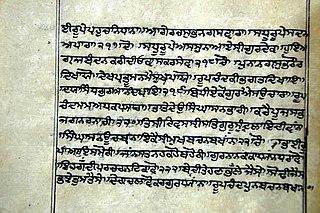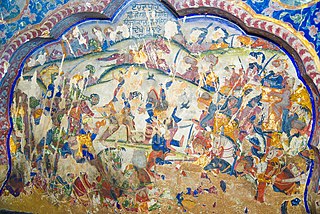This article needs additional citations for verification .(January 2015) |
Bhatt Salh was a Sarswat Brahmin bard in the court of Guru Arjan, whose three hymns are present in Guru Granth Sahib, the holy book of Sikhs. [1]
This article needs additional citations for verification .(January 2015) |
Bhatt Salh was a Sarswat Brahmin bard in the court of Guru Arjan, whose three hymns are present in Guru Granth Sahib, the holy book of Sikhs. [1]

The Guru Granth Sahib is the central holy religious scripture of Sikhism, regarded by Sikhs as the final, sovereign and eternal Guru following the lineage of the ten human gurus of the religion. The Adi Granth, its first rendition, was compiled by the fifth guru, Guru Arjan (1564–1606). Its compilation was completed on 29 August 1604 and first installed inside the Golden Temple in Amritsar on 1 September 1604. Baba Buddha was appointed the first Granthi of the Golden Temple. Shortly afterwards Guru Hargobind added Ramkali Ki Vaar. Later, Guru Gobind Singh, the tenth Sikh guru, added hymns of Guru Tegh Bahadur to the Adi Granth and affirmed the text as his successor. This second rendition became known as the Guru Granth Sahib and is also sometimes referred to as the Adi Granth.

The Bhatra Sikhs are a group within the Sikhs who originated from the bards of the time of Guru Nanak.

Bhat Vahis were scrolls or records maintained by Bhatts also known as Bhatra. The majority of Bhat Sikhs originate from Punjab and were amongst the first followers of Guru Nanak. Bhat tradition and Sikh text states their ancestors came from Punjab, where the Raja Shivnabh and his kingdom became the original 16th century followers of Guru Nanak, the founder of Sikhism. The Raja's grandson Prince Baba Changa earned the title ‘Bhat Rai’ – the ‘Raja of Poets, and then settled himself and his followers all over India as missionaries to spread the word of Guru Nanak, where many northern Indians became Bhat Sikhs. The majority were from the northern Brahmin caste ,(Bhat ) as the Prince Baba Changa shared the Brahmin heritage. The sangat also had many members from different areas of the Sikh caste spectrum, such as the Hindu Rajputs and Hindu Jats who joined due to Bhat Sikh missionary efforts. The Bhats also contributed 123 compositions in the Sri Guru Granth Sahib (pp.1389–1409), known as the "Bhata de Savaiyye". There hereditary occupations consisted of bards, poets, missionaries, astrologists, genealogists, salesmen.

Guru Maneyo Granth refers to the historic statement of the 10th Sikh Guru, Guru Gobind Singh (1666–1708) shortly before his demise on affirming the sacred scripture Adi Granth as his successor, thereby terminating the line of human Gurus. Installed as the Guru Granth Sahib, it is now the central holy scripture of Sikhism, and the eternal living Guru of all Sikhs. It is central to Sikh worship as it is said to imbibe the one light of the creator manifested in the Ten Sikh Gurus‐one spirit in ten forms.

The Battle of Kartarpur occurred on 25 April 1635. It started when the Mughal Empire attacked the town of Kartarpur. The Mughal force was repulsed by the Sikh defenders. The battle occurred in the locality of Kartarpur in present-day Jalandhar district of Indian Punjab.

Jism 2 is a 2012 Indian Hindi-language erotic thriller film produced by Dino Morea and directed by Pooja Bhatt and written by Mahesh Bhatt. It is the sequel to the 2003 sleeper hit Bipasha Basu starrer Jism and marks the debut of Indo-Canadian actress and former pornographic actress Sunny Leone in Bollywood. Jism 2 was launched on 1 December 2011, on popular Indian television series Bigg Boss, making the launch a first time ever in the history of Indian cinema. Mahesh Bhatt compared Jism 2 to Italian romance drama Last Tango in Paris. Jism 2 has been passed with an A-certificate by the Central Board of Film Certification (CBFC) for strong sexual content. Jism 2 had paid previews on 2 August 2012, one day prior to its worldwide release.
Smilie Suri or Smiley Suri is an Indian model, actress and dancer, who appears in Bollywood films. Suri made her debut in acting with the 2005 film, Kalyug, which was directed by her brother, Mohit Suri. The film turned out to be a certified box office huge success.
Urmila Bhatt was an actress of Hindi cinema. She started acting in Drama Theatre. She joined Sangeet Kala Academy in Rajkot as a folk dancer and singer. It was during that time that her famous Gujarati drama Jesal Toral ran to more than a thousand performances. She acted in more than 75 Gujarati films and also in 15 to 20 Rajasthani movies. She had also played character roles in Hindi films for over two and a half decades. She had also acted in various television serials. She also learnt Bharatnatyam under renowned Guru Shri Kubernath Tanjorkar. She had also been honoured with numerous awards by the government of Gujarat.
Bhatt Kal Sahar was a Brahmin bard in the court of Guru Arjan, whose 54 hymns are incorporated in Adi Granth. The title Bhatt is given to learned Brahmins. Traditionally, Kal Sahar is believed to a collector of hymns of other Bhatts which were later incorporated into Guru Granth Sahib by Guru Arjan.

The Guru Granth Sahib, is the central religious text of Sikhism, considered by Sikhs to be the final sovereign Guru of the religion. It contains 1430 Angs, containing 5,894 hymns of 36 saint mystics which includes Sikh gurus, Bhagats, Bhatts and Gursikhs. It is notable among foundational religious scriptures for including hymns from writers of other religions, namely Hindus and Muslims. It also contains teachings of the Sikh gurus themselves.
Bhatt Balh was Brahmin bard in the court of Guru Arjan, whose five hymns are present in Guru Granth Sahib, the holy book of Sikhs.
Bhatt Bhalh was a Brahmin bard in the court of Guru Arjan, whose one hymn is present in Guru Granth Sahib, the holy book of Sikhs.
Bhatt Bhika was a Brahmin bard in the court of Guru Arjan, whose two hymns are present in Guru Granth Sahib, the holy book of Sikhs.
Bhatt Gayand was a Brahmin bard in the court of Guru Arjan, whose 13 hymns are present in Guru Granth Sahib, the sacred scripture of the Sikhs.
Bhatt Harbans was a Brahmin bard in the court of Guru Arjan, whose two hymns are present in Guru Granth Sahib, the holy book of Sikhs.
Bhatt Jalap was a Brahmin bard in the court of Guru Arjan, whose five hymns are present in Guru Granth Sahib, the holy book of Sikhs. Jalap
Bhatt Kirat was a Brahmin bard in the court of Guru Arjan, whose eight hymns are present in Guru Granth Sahib, the holy book of Sikhs. The title Bhatt is given to learned Brahmins.
Bhatt Mathura was a Brahmin bard in the court of Guru Arjan, whose 14 hymns are present in Guru Granth Sahib, the holy book of Sikhs. The title Bhatt is given to learned Brahmins and he is Bhatt Kirat’s brother.
Bhatt Nalh was a Brahmin bard in the court of Guru Arjan, whose 16 hymns are present in Guru Granth Sahib, the holy book of Sikhs.

Sadak 2 is a 2020 Indian Hindi-language action thriller road film directed by Mahesh Bhatt and produced by Fox Star Studios and Mukesh Bhatt under their banner Vishesh Films. A sequel to the 1991 film Sadak, it stars Sanjay Dutt, Alia Bhatt and Aditya Roy Kapur in the lead roles with an ensemble supporting cast, while Pooja Bhatt makes a special appearance. The film marks Mahesh Bhatt's return as a director after 20 years. The film's story takes place twenty-nine years after the events of its predecessor.